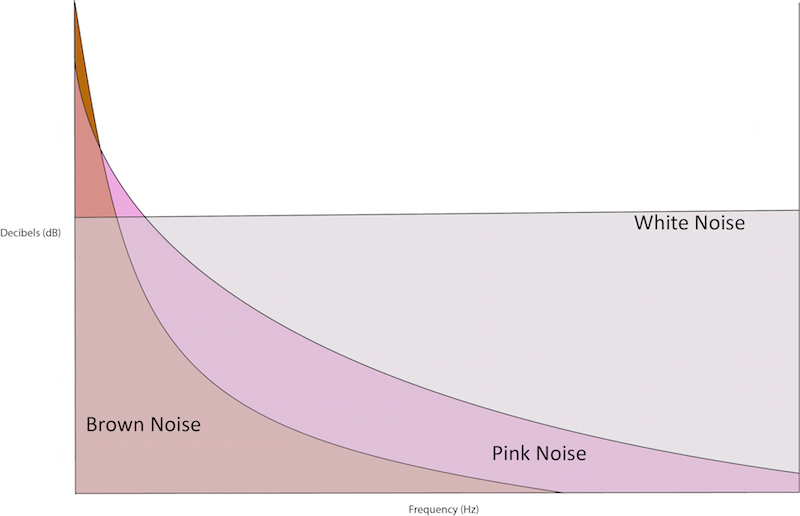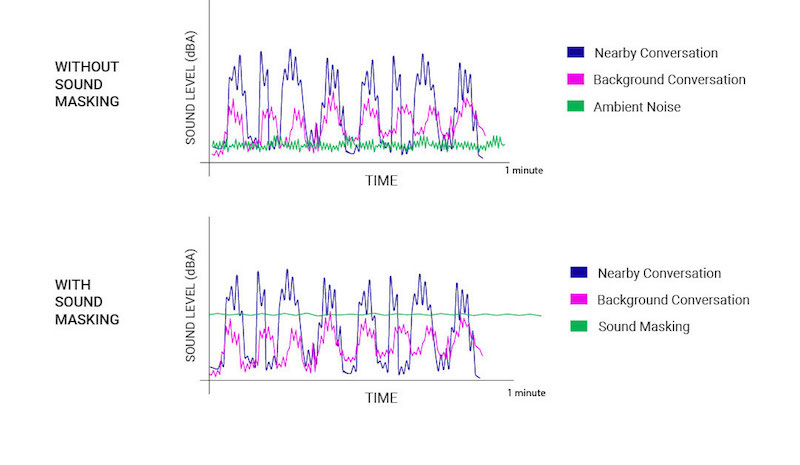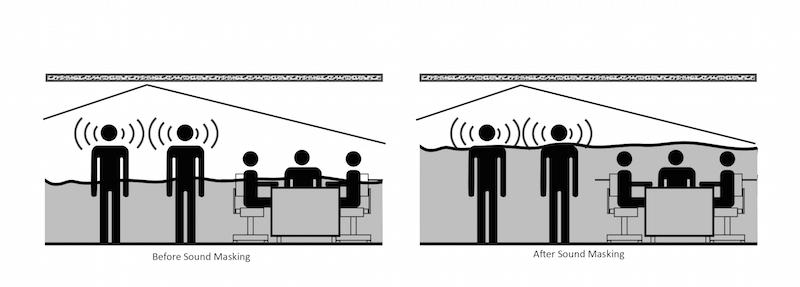Sound Masking is the method of adding ambient noise to a space to “drown out” background distractions and conversations, without impairing the ability to communicate. This is often the least understood sound control methodology, since it is counter-intuitive that adding noise into a space may improve the acoustics within.
Sound masking works by subtly and uniformly raising the ambient background sound in a targeted area, filling it with a non-intrusive sound.
A sound masking system consists of a set of speakers that generate white or pink noise designed to increase the background (or ambient) noise level in a space. By doing so, nearby conversations that are above the masking level will be heard, while those conversations that are further away and other noises below the sound masking level will be inaudible.
Benefits of Commercial Sound Masking
The primary benefits of sound masking are two-fold:
- Speech Privacy: Measured in Privacy Index, which is the % of words of a conversation that are not audible by others. If you are speaking in your office and the coworker next-door cannot hear any of your conversation, then you have 100% Privacy Index. On the other hand, if you can hear 5% of the words, then the Privacy Index is 95%.
- 95% Privacy Index is considered Confidential
- 80% Privacy Index is considered Normal Privacy. Anything below this level may be considered invasive.
- Privacy is critical in a number of industries, including Financials, Medical/Healthcare (HIPAA), Legal, Human Resources. However, it is relevant in almost all commercial settings where privileged information may be exchanged.
- Reducing Distractions/Interruptions (Dynamic Range): this is why sound masking helps you sleep (Auditory Arousal Threshold). By “raising the floor” (increasing the ambient noise in the space), the range from the loudest to quietest moments is less. Studies have shown that instantaneous changes in noise levels of 7 dBA or more are distracting to personnel. While the loud noises are not made quieter, adding background noise results in reducing the range between quiet and loud.
Reducing Costs with Sound Masking
Cost Benefits: Often-times sound masking is cheaper than building walls to deck, while providing an equivalent speech privacy to an STC-rated wall. For instance, an STC 40 wall with Sound Masking has been shown to have equal effectiveness to an STC 50 wall without masking regarding speech privacy. This reduces the cost of bringing all walls to the deck, while also minimizing the schedule critical path for MEP punch-through the sheetrock.
NOTE: Sound Masking is NOT a noise cancellation device. The speakers do not match inbound noise out-of-phase to create a cancellation or interference effect. While this technology may be available in the years ahead, there is not a commercially available noise cancellation device for airborne noise on the market.

Who should install sound masking? A low-voltage certified acoustics firm. Using a standard LV contractor to install sound masking may result in a number of issues with balancing, tuning, and commissioning.
- Balance: Hot Spots and Spacing (headaches)
- Tune: Pink Noise Curvature based on ceiling tiles/plenum-to-ceiling height ratio
- Commission: 48 dBA at 4.5’ off the ground, ramp-up time (daily and on startup)
Speech Privacy – How Sound Masking Provides It
As seen Figure 34, imagine two conversations happening in your office. One is nearby, in which you are engaged, while another is across the room, but clearly audible. In the first graph, notice that the low background noise allows the background, quieter conversation to be plainly heard. Meanwhile, the nearby conversation is also clearly audible.
By raising the background ambient noise to a pre-determined amount, you may create a space that allows comfortable conversation levels for nearby personnel, while background conversations are completely covered, and therefore, private.
The Privacy Index (PI) of the distant conversation may be 60% in the initial chart (such that 40% of the words are understood), but will be 100% once the sound masking is tuned.

Another way to understand the application of sound masking is to look at it spatially. Notice the conversation by two office workers near a table of coworkers. The noise from their conversation drops off with distance, but the table is too close and the ambient noise level in the space too low to provide privacy. However, once the ambient noise level is increased, those nearby are unable to hear the conversation.

Dynamic Range
The other major purpose of sound masking is to reduce distractions in the office. Notice for a moment all of the instances that noise peaks occur in any given 5-minute stretch. Employees in an office setting are constantly distracted by sounds and nearby conversations, and tend to drastically underestimate the number of interruptions that they endure daily.
Any time that a 7-10 dBA increase occurs in a workspace, many employees become distracted and disrupted.
Consider a door slamming in an office, or a motorcycle passing by outside. The background noise of a quiet office sits at around 35dBA, while these impulses may occur at 50 dBA. A 15 dBA jump is alarming in many cases, or clearly noticeable if not. By raising the ambient level to 45 dBA, the Dynamic Range is only 5 dBA (50 – 45), which would not even be noticed by many workers.
While this is similar to privacy, the key to dynamic range is to reduce the number of disruptions, and the extent of them, experienced in the workplace over the course of a day. The corresponding benefit is not the protection of information, but the improved efficiency of employees in the workplace, and employee satisfaction with the office setting.
What is Sound Masking and How it Helps
Sound masking speakers simply “cover” background noise by raising the ambient noise level in a large space. It helps to improve speech privacy in offices where sensitive information is shared, and helps to decrease the amount of distractions workers face.
When considering the pros and cons of Acoustic Wall Panels versus Sound Masking, remember that wall panels help to reduce reverb in a space (making it easier to hear individual conversation or speeches) while sound masking improves speech privacy by adding in background noise. If you’re unsure which is ideal for your space (sometimes it’s both), contact Commercial Acoustics for design guidance and assistance.
This has been an excerpt from the Fundamentals of Architectural Acoustics by Walker Peek.

